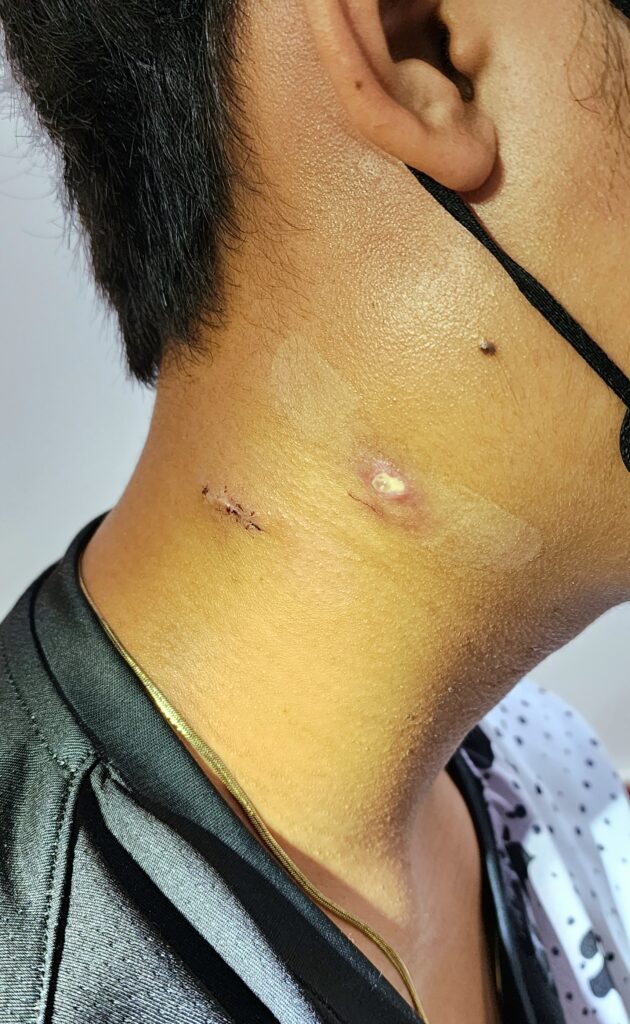Four months ago, a man began noticing a mass on the side of his neck. Initially small, it gradually enlarged and became painful, with pus forming around it. Seeking help from various specialists, he underwent drainage of the abscess and received antibiotic treatment. However, the neck mass persisted, leading him to seek further consultation at the ENT clinic in Palawan. Fine Needle Aspiration Biopsy (FNAB), did not yield conclusive results. Because of this, an incision biopsy was done by an ENT doctor in Palawan which confirmed a diagnosis of tuberculous lymphadenitis, or TB of the neck lymph nodes.
Understanding Tuberculous Lymphadenitis: Causes and Risk Factors
Tuberculous lymphadenitis, also known as scrofula, is a form of tuberculosis that affects the lymph nodes, commonly in the neck. It is caused by the bacterium Mycobacterium tuberculosis. Risk factors include a weakened immune system, close contact with someone who has active tuberculosis, and living in or traveling to areas where tuberculosis is prevalent. Understanding these risk factors is crucial for early detection and prevention.
Symptoms and Initial Diagnosis: Identifying Tuberculous Lymphadenitis
Patients with tuberculous lymphadenitis typically present with swollen lymph nodes in the neck, which may become painful and filled with pus. Other symptoms can include fever, night sweats, and weight loss.
In this case, the patient experienced a progressively enlarging neck mass with recurrent abscess formation. Diagnostic procedures done by his ENT doctor in Palawan included a physical examination, imaging studies, and confirmatory tests such as AFB and FNAB. Early and accurate diagnosis is vital to differentiate it from other causes of neck masses, such as bacterial infections or malignancies.

Medical Management and Treatment Options
The patient, in the case above, was then started on a six-month course of anti-tuberculosis (anti-Koch’s) treatment by his ENT doctor in Palawan. This is the cornerstone of treatment for tuberculous lymphadenitis: a prolonged course of anti-tuberculosis medications, typically lasting at least six months. This regimen often includes a combination of drugs such as isoniazid, rifampicin, ethambutol, and pyrazinamide. Adherence to the full course of treatment is critical to ensure complete eradication of the infection, otherwise the patient is at risk of developing drug-resistant tuberculosis.
Surgical Interventions for TB Adenitis: When and Why They Are Needed
While most cases of tuberculous lymphadenitis can be managed medically, surgical intervention may be necessary in certain situations. Indications for surgery include failure of the mass to respond to medical treatment, the presence of large abscesses, or complications such as sinus tract formation. Surgical procedures done by an ENT doctor near you may involve excision of the affected lymph nodes or drainage of abscesses. Post-surgical care focuses on wound management and continued anti-tuberculosis therapy to ensure complete recovery.

Challenges, Management, and Recovery of Tuberculous Lymphadenitis
Managing tuberculous lymphadenitis involves addressing complications like chronic abscesses, sinus tracts, and drug-resistant tuberculosis, along with side effects from prolonged medication use, such as liver toxicity and gastrointestinal issues. Effective strategies include closely monitoring treatment response, adjusting regimens, and providing supportive care. Recovery requires comprehensive medical treatment, regular follow-ups, patient education on medication adherence, and lifestyle modifications. Nutritional support, rest, and avoiding further infections are crucial. Patients, like the patient above, who complete treatment need ongoing monitoring to prevent recurrence and manage long-term effects.
In conclusion, tuberculous lymphadenitis of the neck is a challenging condition that requires a combination of accurate diagnosis, effective medical treatment, and sometimes surgical intervention. With comprehensive care and strict adherence to treatment protocols, patients can achieve full recovery and return to normal life. If you are experiencing similar symptoms, it’s crucial to consult an ENT doctor near you for proper diagnosis and treatment.
Experience expert ENT surgical care tailored to your needs.
Book now to schedule your appointment with a skilled ENT surgeon near you and take the first step towards a healthier you.
Your well-being is our top priority.

